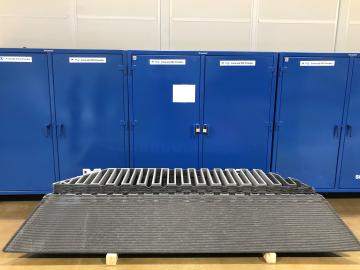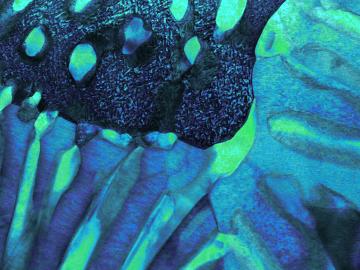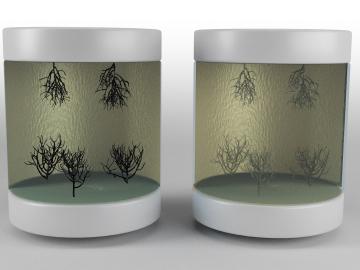
Filter News
Area of Research
- Advanced Manufacturing (14)
- Biology and Environment (47)
- Biology and Soft Matter (1)
- Building Technologies (1)
- Computational Engineering (2)
- Computer Science (7)
- Electricity and Smart Grid (2)
- Energy Science (118)
- Energy Sciences (1)
- Fusion and Fission (5)
- Fusion Energy (1)
- Isotopes (1)
- Materials (30)
- Materials for Computing (6)
- Mathematics (1)
- National Security (17)
- Neutron Science (13)
- Nuclear Science and Technology (2)
- Quantum information Science (7)
- Sensors and Controls (1)
- Supercomputing (41)
News Type
News Topics
- (-) 3-D Printing/Advanced Manufacturing (89)
- (-) Clean Water (30)
- (-) Energy Storage (64)
- (-) Grid (54)
- (-) Machine Learning (51)
- (-) Quantum Computing (39)
- (-) Quantum Science (58)
- Advanced Reactors (25)
- Artificial Intelligence (92)
- Big Data (62)
- Bioenergy (84)
- Biology (100)
- Biomedical (53)
- Biotechnology (28)
- Buildings (50)
- Chemical Sciences (48)
- Composites (21)
- Computer Science (153)
- Coronavirus (30)
- Critical Materials (17)
- Cybersecurity (17)
- Education (2)
- Emergency (4)
- Environment (164)
- Exascale Computing (52)
- Fossil Energy (7)
- Frontier (45)
- Fusion (47)
- High-Performance Computing (93)
- Hydropower (12)
- Irradiation (2)
- Isotopes (38)
- ITER (7)
- Materials (87)
- Materials Science (89)
- Mathematics (11)
- Mercury (10)
- Microelectronics (3)
- Microscopy (34)
- Molten Salt (7)
- Nanotechnology (29)
- National Security (63)
- Neutron Science (109)
- Nuclear Energy (85)
- Partnerships (37)
- Physics (38)
- Polymers (18)
- Security (17)
- Simulation (51)
- Software (1)
- Space Exploration (23)
- Statistics (3)
- Summit (48)
- Transportation (66)
Media Contacts

Deborah Frincke, one of the nation’s preeminent computer scientists and cybersecurity experts, serves as associate laboratory director of ORNL’s National Security Science Directorate. Credit: Carlos Jones/ORNL, U.S. Dept. of Energy

Oak Ridge National Laboratory researchers, in collaboration with Cincinnati Inc., demonstrated the potential for using multimaterials and recycled composites in large-scale applications by 3D printing a mold that replicated a single facet of a

Through a consortium of Department of Energy national laboratories, ORNL scientists are applying their expertise to provide solutions that enable the commercialization of emission-free hydrogen fuel cell technology for heavy-duty

Oak Ridge National Laboratory scientists proved molybdenum titanium carbide, a refractory metal alloy that can withstand extreme temperature environments, can also be crack free and dense when produced with electron beam powder bed fusion.

Scientists at Oak Ridge National Laboratory have devised a method to identify the unique chemical makeup of every lithium-ion battery around the world, information that could accelerate recycling, recover critical materials and resolve a growing waste stream.

Oak Ridge National Laboratory was among an international team, led by Lawrence Livermore National Laboratory, who synthesized 108 elevated carbon dioxide, or CO2, experiments performed in various ecosystems to find out how much carbon is

Researchers at Oak Ridge National Laboratory have identified a statistical relationship between the growth of cities and the spread of paved surfaces like roads and sidewalks. These impervious surfaces impede the flow of water into the ground, affecting the water cycle and, by extension, the climate.

Scientists at Oak Ridge National Laboratory successfully demonstrated a technique to heal dendrites that formed in a solid electrolyte, resolving an issue that can hamper the performance of high energy-density, solid-state batteries.

Oak Ridge National Laboratory researchers combined additive manufacturing with conventional compression molding to produce high-performance thermoplastic composites reinforced with short carbon fibers.

A team of researchers at Oak Ridge National Laboratory and Purdue University has taken an important step toward this goal by harnessing the frequency, or color, of light. Such capabilities could contribute to more practical and large-scale quantum networks exponentially more powerful and secure than the classical networks we have today.


